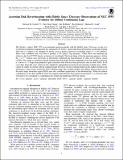Files in this item
Accretion disk reverberation with Hubble Space Telescope observations of NGC 4593 : evidence for diffuse continuum lags
Item metadata
| dc.contributor.author | Cackett, Edward M. | |
| dc.contributor.author | Chiang, Chia-Ying | |
| dc.contributor.author | McHardy, Ian | |
| dc.contributor.author | Edelson, Rick | |
| dc.contributor.author | Goad, Michael R. | |
| dc.contributor.author | Horne, Keith | |
| dc.contributor.author | Korista, Kirk T. | |
| dc.date.accessioned | 2018-04-24T10:30:14Z | |
| dc.date.available | 2018-04-24T10:30:14Z | |
| dc.date.issued | 2018-04-12 | |
| dc.identifier | 252910413 | |
| dc.identifier | fa9e22a0-8e8e-4210-afdd-f2a3f1821b56 | |
| dc.identifier | 85045558808 | |
| dc.identifier | 000429924900004 | |
| dc.identifier.citation | Cackett , E M , Chiang , C-Y , McHardy , I , Edelson , R , Goad , M R , Horne , K & Korista , K T 2018 , ' Accretion disk reverberation with Hubble Space Telescope observations of NGC 4593 : evidence for diffuse continuum lags ' , Astrophysical Journal , vol. 857 , no. 1 , 53 . https://doi.org/10.3847/1538-4357/aab4f7 | en |
| dc.identifier.issn | 0004-637X | |
| dc.identifier.other | ArXiv: http://arxiv.org/abs/1712.04025v2 | |
| dc.identifier.uri | https://hdl.handle.net/10023/13190 | |
| dc.description | K.H. acknowledges support from STFC grant ST/M001296/1. | en |
| dc.description.abstract | The Seyfert 1 galaxy NGC 4593 was monitored spectroscopically with the Hubble Space Telescope as part of a reverberation mapping campaign that also included Swift, Kepler and ground-based photometric monitoring. During 2016 July 12 - August 6, we obtained 26 spectra across a nearly continuous wavelength range of ~1150 - 10,000 Å. These were combined with Swift data to produce a UV/optical "lag spectrum", which shows the interband lag relative to the Swift UVW2 band as a function of wavelength. The broad shape of the lag spectrum appears to follow the τ ∝ λ 4/3 relation seen previously in photometric interband lag measurements of other active galactic nuclei (AGN). This shape is consistent with the standard thin disk model but the magnitude of the lags implies a disk that is a factor of ~3 larger than predicted, again consistent with what has been previously seen in other AGN. In all cases these large disk sizes, which are also implied by independent gravitational microlensing of higher-mass AGN, cannot be simply reconciled with the standard model. However the most striking feature in this higher resolution lag spectrum is a clear excess around the 3646 Å Balmer jump. This strongly suggests that diffuse emission from gas in the much larger broad-line region (BLR) must also contribute significantly to the interband lags. While the relative contributions of the disk and BLR cannot be uniquely determined in these initial measurements, it is clear that both will need to be considered in comprehensively modeling and understanding AGN lag spectra. | |
| dc.format.extent | 12 | |
| dc.format.extent | 2233802 | |
| dc.language.iso | eng | |
| dc.relation.ispartof | Astrophysical Journal | en |
| dc.subject | Galaxies: active | en |
| dc.subject | Galaxies: individual (NGC 4593) | en |
| dc.subject | Galaxies: nuclei | en |
| dc.subject | Galaxies: Seyfert | en |
| dc.subject | QB Astronomy | en |
| dc.subject | QC Physics | en |
| dc.subject | NDAS | en |
| dc.subject.lcc | QB | en |
| dc.subject.lcc | QC | en |
| dc.title | Accretion disk reverberation with Hubble Space Telescope observations of NGC 4593 : evidence for diffuse continuum lags | en |
| dc.type | Journal article | en |
| dc.contributor.sponsor | Science & Technology Facilities Council | en |
| dc.contributor.institution | University of St Andrews. School of Physics and Astronomy | en |
| dc.contributor.institution | University of St Andrews. St Andrews Centre for Exoplanet Science | en |
| dc.identifier.doi | https://doi.org/10.3847/1538-4357/aab4f7 | |
| dc.description.status | Peer reviewed | en |
| dc.identifier.grantnumber | ST/M001296/1 | en |
This item appears in the following Collection(s)
Items in the St Andrews Research Repository are protected by copyright, with all rights reserved, unless otherwise indicated.

